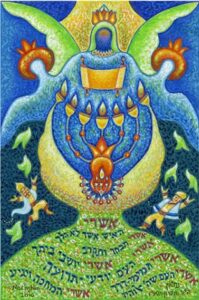בס”ד
By Rabbi Moshe Goodman, Kollel Ohr Shlomo, Hebron

The Kabbalists attach importance to the 720 permutations of the word “breshit” that begins the Torah. One of these permuatations spells the words “ashrei bat,” literally meaning the “joyous daughter.” According to the Kabbalah this may hint to the Holy Presence called “a daughter,” “a bride,” or the “Shabbat Queen.” Indeed, in this painting we see a figure that seems to resemble a “celestial queen.” Surrounding her are dancing hasidim en-robed in taleisim, which is mentioned in the Talmud and the Kabbalah as the dress to greet the “Shabbat Queen.” The Torah scroll is seen here as well, a matter that hints to the deep connection between Torah and the resting of the Holy Presence. The Holy Presence is especially associated with the number seven, and the seventh day – Shabbat, as we mentioned. Therefore, we see seven verses, seven leaves, and the seven candles of the Menora. We also see a separate theme of the number three in the three-pronged Shin and the three pomegranates. The pomegaranate has a “crown” look to it, which may hint to the sefira of keter and the other two sefirot adjacent to it, I.e hochma and bina, which are considered to rise “atop” the seven lower sefirot, hinted by the number seven theme here.
Regarding the seven verses that begin with the word “ashrei,” it seems that the first verse, which opens the bok of tehilim hints to the opening sefira of hesed. Also this verse continues with the conduct of the pious person who is “occupied with Torah study,” and Torah study is associated with the sefira of hesed, as it says “and the Torah of kindness [hesed] is on her tongue” [last chapter of Mishlei]. Similar to this is the verse “ashrei temimei darech” which opens chapter 119 of Tehilim, which talks extensively about Torah study. However, the Kabbalists attach the concept of “derech” – “the way” to the sefira of netzach, associated with the leg that walks on the way. Therefore, it seems that this verse refers to netzach which is considered to be on the “right side of the sefira scale” just like the hesed, which also dealt with Torah study. The verse “ashrei tivchar” emphasizes Hashem’s guidance upon holy locations, allowing those close to Him to be in these holy locations. Kabbalists consider location/earth etc. to be a feminine aspect, assocaited with the sefira of gevura. Then, there is another verse the bridges between the first verse talking about the pious involved with Torah study, and the second verse emphasizing more the merit to be in the holy location. This “bridging” verse is “ashrei yoshvei betecha”, which talks about the pious individual – “yoshvei- those who sit [I.e occupied in deep Torah study where one sits] and also his benefit to be in the holy location – betecha – the holy house. “Bridging” or uniting different aspects is associated by the Kabbalists to the sefira of tiferet. Parallel to this is the verse “ashrei ha’am sheHashem Elokav.” This verse represents the special unity between Hashem and His People Israel. Therefore, this verse seems to correspond to the yesod, which is in the same “middle-uniting path” as the tiferet. The verse talkning abou blowing the shofar seems to be associated with the sefira of hod – the fifth sefira, connected to Thursdays – the fifth day of the week. On this day we say a song from Tehilim “shir shel yom” which mentions the blowing of the shofar [there is more on this but we must be concise here]. The last verse on the bottom left is actually not from Tehilim, unlike all the other verses, but rather from the end of the book of Daniel, which discusses the timings of the redemption and mashiach. This seems to hint to the sefira of malchut which means kingship, and the mashiach is meant to be a king.
During these tumultious days in our Holy Land, let us strengthen our confidence in Hashem’s salvation, remembering that the Holy Presence fights before us, as the the verse says “ for Hashem your God is walking among your camps to save you and give your enemy before you [in your hands] (Dvarim 23, 15).” Let us all be invigored by this and the valour of Hebron from which the first Jewish war ensued, as Avraham our Father left from Hebron to battle the four kingdoms to save Lot from which King Mashiach would later emerge.



